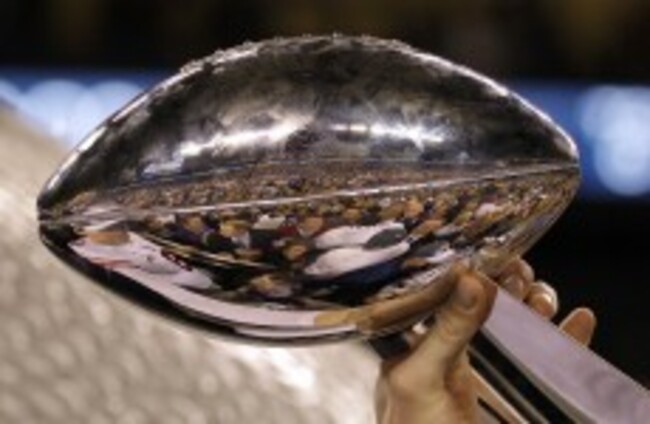Updated Sunday February 2.
FOR SOME OF you, Super Bowl XLVIII between the Denver Broncos and Seattle Seahawks tonight may well be your first experience of American football.
With that in mind, we’ve put together this handy guide to help you learn the difference between offence and defence, between a touchdown and a field goal and, perhaps most confusingly, between a safety (the play) and a safety (the player).
The league:
The NFL contains 32 teams split into two conferences, the American Football Conference (AFC) and the National Football Conference (NFC). Each conference is separated into four divisions, North, South, East and West with four teams in each. You can find a breakdown of each division here.
The field:
An American football pitch (or field) is 120 yards long and 53.3 yards wide. The most important parts are the two endzones, with one located at either end of the field. The ten yards between the front and back of the endzone is where touchdowns are scored.
The teams:
Each team has specialists on offence, defence and special teams but never have more than 11 players on the field at one time. In the NFL there are 53 active players allowed on every team which is why you see so many people standing along the sidelines during a game.
You can see how most teams line up on offence and defence here.
The offence is made up of:
- The offensive line (two guards, two tackles and a centre who protect the quarterback and running backs from being tackled).
- Two/four wide receivers who catch the ball or block on running plays.
- One/two tight ends who catch the ball or block on certain passing and running plays.
- One/two running backs who run and catch the ball while also blocking for the quarterback on some plays.
- The quarterback, who can pass, run with, or hand the football to the running back.
The defence is made up of:
- The defensive line who try to stop the quarterback and running back from moving the football.
- Linebackers who push forward to try and stop the running back and tackle the quarterback.
- Corner backs and safeties who, primarily, try to stop the receivers from catching the ball.
A map showing the geographic spread of all 32 NFL teams.
The play:
Possession in American football is similar to rugby league, with each offence having four ‘downs’ to advance the ball ten yards. When the offence succeeds in moving the ball at least ten yards, they are awarded with a fresh set of downs, meaning they have four more attempts.
To move the ball, a team can choose to run or throw, but only one forward pass is allowed in each play. The quarterback is perhaps the most well-known position in American football and, like an on-field general, he touches the ball on almost every play and — with the help of the offensive coordinator — decides if a play will involve a run, a pass or, in some cases, both. Trick plays, known as ‘play action’ are often used to fool defences.
In most cases, if a team has failed to move the ball forward ten yards on the first three downs, they punt the ball away (like kicking for position in rugby) or kick a field goal (worth 3 points) on the fourth.
Scoring:
Instead of field goals, most teams want to score touchdowns. These are registered when a team either runs or passes the ball into the endzone and are worth six points, with the point after (think conversion in rugby) worth one. You can also go for a two-point conversion by running or throwing into the endzone.
While it is usually the offence that scores, the defence can get in on the action too. If the defence intercepts a pass (a pick) or forces an opposition player to fumble the football, they can run the ball into their opponent’s endzone for six points.
Defences can also force a safety. This is worth two points and occurs if they tackle an offensive player in the offence’s own endzone.
The clock:
Games are divided into four 15-minute quarters, separated by a 12-minute break at halftime. There are also two minute breaks at the end of the first and third quarters as teams change ends of the field. At the end of the first and third quarters, the team with the ball retains possession heading into the following quarter.
Each offensive team has 40 seconds from the end of a given play until they must snap of the ball for the start of the next play, otherwise they will be penalised.
The clock stops at the end of incomplete passing plays, when a player goes out of bounds, or when a penalty is called. The clock starts again when the ball is re-spotted by an official.
If a game is a draw (tied) at the end of regulation, a 15-minute overtime period will be played. In the NFL, the first team to score a touchdown wins. A field goal can also win a game in overtime but only if both teams have had possession of the football.
Basics:
So, that’s the basics of American football covered but there’s a lot more goes on during a game than we can deal with here. However, I will be answering any questions you may have in tonight’s Super Bowl liveblog/open thread.
Originally published January 28, 2013.












Might have missed it but did the IRFU ever clarify why Ireland is the only top tier nation, possibly one of the only rugby nations, that never invested in 7s? Is there actually a good reason? The 7s circuit is huge, a 7s event in Dublin would be class, it always attracts a crowd.
They did, they said that costs were too high and were better spent on the 15s game. It was David Nucifora that convinced them that it would be an effective pathway for developing players that may otherwise slip through. I’ve seen it suggested that they would have to be seen to be running a 7s program to help with the RWC2023 bid. Not sure about that one though.
There are 7s events in Ireland. Dublin 7s was about a month ago in Donnybrook. Then obviously there’s Kinsale 7s which has a big draw.
Think he meant a world series event
Spain got the last spot in the last second of the final against Samoa . They had beaten Ireland in the quarters . Ireland did well to get so far considering they have only one full season under their belts.
Definitely. Qualification for 2020 was always the goal so to get so close for 2016 is great encouragement.
Sean, what’s the story with Olympic qualification? Has that ship sailed or are we still in with a chance?
Spain got the last spot